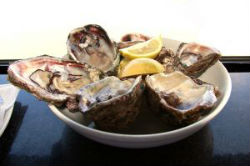
13 Easy Ways to Improve Your Immune System Naturally in 2013
By LaKenya McClough, MPH
Happy New Year family! Given the recent spike in flu incidences in California and across the country, I thought it might be helpful to highlight a few more options on how to stay healthy this season. In this article, I’m sharing with you 13 different and simple ways you can naturally boost your immune system. These are not new ideas. In fact, they are easy everyday practices that when adopted on a regular basis can make a world of difference for your health and may even help prevent you from getting the flu!
Tip #6 of 13 — Zinc
It’s no secret proper diet and nutrition are a great way to get and stay healthy. During the winter, Zinc helps the body go a step further boosting your immune system to help fight off cold and flu. Zinc affects multiple aspects of the immune system. Primarily, it helps prevent viruses from fully accessing our cells. (Huffington Post) Zinc is also crucial for normal development and function of various cells throughout the body. (National Institutes of Health)
Getting Zinc from foods naturally can be relativlely simple. Oysters and wheat germ are excellent sources for Zinc. But if neither of these tickle your fancy, there are a host of other great foods that can do the same. Below is a list of foods rich in Zinc and the Zinc content, all courtesy of a website with an interesting name, “Healthiliciousness.com.”
#1: Oysters
Depending on type and variety oysters provide 16-182mg of zinc per 100g serving. This accounts for 110%-1200% of the DV for zinc. The food highest in zinc is The Steamed Wild Eastern Oyster which provides 182 mg of zinc per 100g serving, or 76mg (509% DV) in 6 oysters, and 154mg (1029% DV) in a 3 ounce serving.
#2: Toasted Wheat Germ
Packed in jars and sold toasted, wheat germ is great to sprinkle on top of any food. Try it on salads, rice, or steamed vegetables. Toasted wheat germ provides 17mg (112% DV) of zinc per 100g serving, which is 19mg (126% DV) per cup, and 1.2mg (8% DV) in a single tablespoon. Crude (untoasted) wheat germ provides 12mg (82% DV) of zinc per 100g serving, 14mg (94% DV) per cup, and 1mg (6% DV) per tablespoon.
#3: Veal Liver
The liver of any animal is packed with vitamins and minerals and most commonly served as pâté or liverwurst. Veal liver has the most zinc with 12mg per 100g serving accounting for 81% of the DV, that is 8.98mg of zinc (60% DV) in a cooked slice of liver (80g). Liver is best prepared steamed or fried with onions and herbs.
#4: Low Fat Roast Beef
Low fat beef shoulder, shank, and chuck all contain about 10mg (70% DV) of zinc per 100g serving, 18mg (119% DV) per pound, and 9mg (59% DV) in a 3 oz serving. If you buy pre-processed roast beef be sure to consult the nutrition facts about the cut and nutrients. Not all nutrition labels report zinc, so don’t worry if you don’t see it.
#5: Roasted Pumpkin and Squash Seeds
A popular food in the Middle East and East Asia pumpkin and squash seeds contain about 10mg (70% DV) of zinc per 100g serving, 6.6mg (59% DV) per cup, and 3mg (19% DV) per ounce (~85 seeds). If you can’t find these in your local supermarket you will surely find them in Middle Eastern or East Asian specialty stores. Alternatively, you can also save any pumpkin and squash seeds you have and roast them in your oven. The seeds are typically eaten by cracking the outer shell and eating the seed inside.
#6: Dried Watermelon Seeds
Much like the pumpkin and squash, watermelon seeds are popular in the Middle East and East Asia and they should be in specialty stores catering to those cultures. It is also possible to just eat the seeds raw with the watermelon. You can shell them, or just chew them up whole. Dried watermelon seeds provide 10mg (70% DV) of zinc per 100g serving, 11mg (74 %DV) per cup, and 3mg (19% DV) per ounce.
#7: Dark Chocolate and Cocoa Powder
Chocolate is showing more and more health benefits and dark chocolate is coming into vogue. Unsweetened baking chocolate provides 9.6mg (64% DV) of zinc per 100g serving (most bars are 50-100 grams). Cocoa powder will provide 6.8mg (45% DV) per 100g, or 5.4mg (39% DV) per cup, 0.3mg (2% DV) per tablespoon. Most milk chocolates provide around 2.3mg (15% DV) per 100g serving or 1mg (7% DV) per bar.
#8: Lamb (Mutton)
Lamb is a common meat in the Middle East, Mediterranean, and most of Europe, but is increasing in popularity in the Americas. Lamb provides between 4.2-8.7mg of zinc per 100g serving (28%-58% DV) depending on cut. That is up to 7.4mg (49% DV) in a 3 ounce serving (85 grams).
#9: Peanuts
Peanuts are a great source of zinc, 100 grams of oil roasted peanuts will provide 6.6mg (44% DV) of zinc, or 8.8mg (59% DV) in 1 cup chopped, 1.9mg (12% DV) per oz (~39 peanuts). Dry roasted peanuts will provide half as much zinc at 3.3mg (22% DV) per 100 gram serving, or 4.8mg (32% DV) per cup, and 1mg (6% DV) per oz.
#10: Crab
Almost any kind of crab will be a great source of zinc. Alaska King crab in particular provides 7.6mg (51% DV) of zinc per 100 gram serving, which is 10.2mg (68% DV) in an average crab leg, and 6.5mg (43% DV) in a 3 ounce serving.
Click here to see Tip #1 of 13
Click here to see Tip #2 of 13
Click here to see Tip # 3 of 13
Click here to see Tip #4 of 13
Click here to see Tip # 5 of 13





